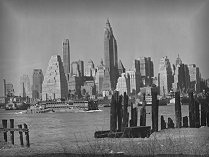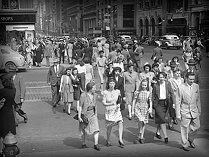
 |
|
TO PAGE: 1 • 2 • 3 • 4 • 5 • 6 • 7 • 8 • 9 • 10 • 11 • 12 • 13 • 14 • 15 |
![]()
BOYHOOD
|
| Mrs. Rebecca Lepofsky named Manford after a leading character in a magazine love story she
was reading shortly before her delivery. The doctor registered the boy's
birth certificate
as Emanuel. A similar thing happened when her sister Dora Nathan gave birth to her son
nine months later, the doctor now seemed to dislike the name Daniel which his parents
gave him and filled in the birth certificate as David. This was not even
known to close relatives as Richard Dannay confided: "After his death, I came across a copy of his petition to change his
name to Frederic Dannay from -- David Nathan!" Both changed their names as young men, Lepofsky truncating and anglicizing his last name and modifying his first to a name meaning "man of peace", Dannay constructing a surname out of the first syllables of his birth names and taking "Frederic" out of admiration for the music of Chopin. Friends and family kept calling them "Manny" and "Dan" or "Danny." |
|
|
| As eldest of three children Lee lived together in Brooklyn with sisters
Helen and Rena. His sisters never married and put Manny through college.
Helen worked in television and Rena for Time Magazine. He attended Boys' High (now Boys' and Girls' High). As a child, Lee
had a difficult time with what he termed "the brutality of the streets," so he
turned "for refuge" to books. Dannay's family moved to then-rural Elmira, New
York, when he was a small boy. This hometown of Mark Twain gave him a real "Tom
Sawyer-like" boyhood together with a best friend named... Ellery. During vacations Manny went on holidays to his cousin en once in 1914 he even stayed the entire vacation. In 1917 the family decided to returned to Brooklyn to live in the Wallersteins house. He left P.S. 156, Sutter & Grafton Sts. in 1917. During the first winter  Danny was
bed stricken by a abscess to the left ear and one of his aunts
handed him Conan Doyle's
Adventures of Sherlock Holmes. It changed his life... Danny was
bed stricken by a abscess to the left ear and one of his aunts
handed him Conan Doyle's
Adventures of Sherlock Holmes. It changed his life...Together with Manny he now attended Boys' High. Much more as brothers they shared the same interests such as baseball and detective stories. It's in their mid-teens, coming to and from New York, whilst sharing a cab, streetcar,...they started plotting impossible crimes, playing with ideas. They even plotted a crime in the (for them) almost "holy sanctuary" of a public library. They concentrated on the "how" rather than the "who"... Eventually they changed the location to the museum to work out this closed-room-mystery. |


| Manny graduated
from Boy's High in 1921 and went on to the New York University (NYU), whilst working as a
Western Union messenger. "In the 1920s, when Dad applied to New York University as Emanuel
Benjamin Lepofsky, he discovered that Jewish students were among the ethnic
groups barred from attending the main NYU campus. Later, when he was about
to graduate from the Greenwich Village campus of NYU with a summa cum laude
degree in English, Dad told a faculty friend of his dream of becoming a
college English professor at his alma mater. The “friend” replied, “Oh,
Manny, no Jew will ever get tenure in the NYU system—you are all so much
smarter than we Gentiles, it wouldn’t be fair to the rest of us.” This
prompted my father to abandon his professorship dreams, and change his name."
(The Story is the Thing, Rand B. Lee)
Next to being a Western Union telegraph boy Manfred had other interim working activities: packer women's fur coats, ribbon clerk wholesale dry goods house, dishwasher refreshment stand, and member of a jazz band. Patricia Lee Caldwell recalls: "Hy Miller attended college at New York University and there met Manny Lee. Uncle Hy had a great singing voice and may also have played some instrument and some time later they formed a band with three or four other students and performed in various venues, including on some cruises and at some vacation spots." (Arthur Vidro) This was the five piece jazz-band Manny directed for a while (he was an excellent violin player). At NYU he majored English and philosophy where he got the Chancellor's first prize English composition in 1922; short stories NYU literary magazine; editor college annual, 1924. Manfred B. Lee "Poffy" completed his studies "cum laude" at the New York university in 1925 and his new adjusted ambition back then was to be a serious writer, a "20th century Shakespeare". |
|
|
Manfred's mother wanted him to go on to law school but soon after, in 1926, found his way into advertising as redactor of slogans and scripts for film companies (FBO Pictures co. 1926 - 1927; Sterling Pictures, 1927 - 1928; Gotham Pictures, 1928; later Pathé, 1930). "Mannie Lee" (sic) was described as a swell copy writer and layout man. At some point in 1926 Hy brought his friend and fellow band member Manny Lee to Philadelphia for a weekend to meet the family. That weekend, Manny Lee met Claremont-born Betty Miller (July 30. 1909 - ). After that, he commuted regularly to her home on Memorial Day, Easter, and graduation day and on the fourth visit they became engaged. One year later the couple was married (Aug 6. 1927) in Manhattan, they spent their honeymoon in New York. After working for several years with
the
Film Booking Offices (FBO) in the
publicity and advertising department Lee had quit that company early in 1927
to join Henry Ginsberg at Sterling Pictures Distributing Corporation. He was
to devote much of his time to the formulation and preparation of story
material for screening purposes. That same year Manfred (under the name Manfred Lee) wrote,
together with Frances Guihan, the story for the silent movie Closed Gates, directed by
Phil Rosen. E.G. Johnston reviewed the movie in Motion Picture News:
"Manfred B. Lee, who wrote the story for this feature, offers this one
in proof of his statement that the independent producer CAN make Broadway
pictures. We are inclined to agree with Mr. Lee, for certainly it is on a
par with many that have secured Metropolitan first runs. At least two of
several dramatic situations reach considerable height." In June
Manny took two weeks to recover from the inglorious mumps. |
|
|
It was Mike Simmons who took Manfred
Lee into Gotham Pictures (May 1928).
However in 1929 Manfred worked as a writer at Pathé, where he was
commissioned, among other things, to compile the AMPA yearbook together with
Mike Simmons, the presentation in March would form one of the distinctive
features of the Hollywood Masque Ball staged at the New York Astor Hotel. Dannay had his own ambitions wanting to be a poet. Even now faith dealt him a feebler hand. Prohibition meant his father was out of business and he had to quit Boy's High before his graduation. In 1921 at sixteen and in his third year High School he went working to help out the family. His after- school job as a soda fountain clerk set aside his first full-time position was as a bookkeeper but not his last. For the next seven years he jumped from job to job and the family's financial position changed. Danny could even receive his high school diploma (1922) and even took some courses in the Arts Students' League (to paint). By 1928 Fred worked as a copy writer, art director for a NY advertising agency. He left the United Advertising agency for the copy department at the Caples Company, a national ad agency. There he was art director at least until 1932 and was art and typographic counsel to Superior Typography, Inc. |
|

 |
|
|
Their offices were at walking distance and since their interests were basically the same, "Manny" and "Danny" met on a regular basis and frequently went out for lunch together. They were fascinated by the crime and decided to write about it. One of those fascinations was Joseph Bowne Elwell, the greatest bridge player alive, the so-called "Wizard of Whist", a tutor of the game to the King of England and the millionaire Vanderbilts. Author of best-selling bridge textbooks, an unofficial "spycatcher" and intelligence agent, a heavy gambler on the stock exchange, the owner of a large stable of race horses, a developer of Florida real estate, a dealer of bootleg liquor, and an industrious philanderer. Joseph Elwell is believed to be the inspiration for F. Scott Fitzgerald's Jay Gatsby in his book, The Great Gatsby. Today Joseph Elwell is remembered for being murdered in June 1920 in a classic "locked room" mystery---to this day still unsolved. Someone managed to sneak into his art-filled house in Manhattan, shoot Elwell in the head, and vanish into thin air.....leaving Elwell in a room locked from the inside! The Slaying of Joseph Bowne Elwell is author Jonathan Goodman's fascinating account of the corrupt life and mysterious death of one bizarre man. The Elwell case has been used as the basis of many crime novels (including one of the most famous, S.S. Van Dine's The Benson Murder Case), films, and a play. Supposedly this case resulted in the formation of the writing partnership. They would set their teen-age fantasies aside and write a "serious" book in the Van Dine-manner. They only needed the spark to set it off... |
|
|

|
| Introduction | Floor Plan | Q.B.I. |
List of Suspects | Whodunit? | Q.E.D. | Kill as directed | New | Copyright Copyright © MCMXCIX-MMXXV Ellery Queen, a website on deduction. All rights reserved. |